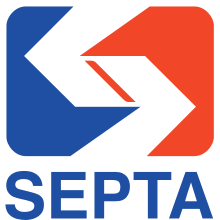SEPTA
 |
|||
| Overview | |||
|---|---|---|---|
| Locale | Delaware Valley | ||
| Transit type | |||
| Number of lines | 196 | ||
| Number of stations | 290 | ||
| Annual ridership | 329,931,400 (2014) | ||
| Headquarters | 1234 Market Street Philadelphia, Pennsylvania |
||
| Website | SEPTA | ||
| Operation | |||
| Began operation | 1965 | ||
| Operator(s) | SEPTA (one route in Montgomery Co. contracted) |
||
| Reporting marks | SEPA SPAX |
||
| Number of vehicles | 2,295 | ||
| Technical | |||
| System length | 450 mi (720 km) | ||
| Track gauge |
4 ft 8 1⁄2 in (1,435 mm) standard gauge 5 ft 2 1⁄4 in (1,581 mm) |
||
|
|||
 Geographically-accurate map of SEPTA and connecting rail transit services. Includes Regional Rail, rapid transit, and selected interurban and suburban trolley lines. Does not include SEPTA's subway-surface lines or Girard streetcar.
Geographically-accurate map of SEPTA and connecting rail transit services. Includes Regional Rail, rapid transit, and selected interurban and suburban trolley lines. Does not include SEPTA's subway-surface lines or Girard streetcar.
The Southeastern Pennsylvania Transportation Authority (SEPTA) is a regional public transportation authority that operates various forms of public transit services—bus, subway and elevated rail, commuter rail, light rail and electric trolleybus—that serve 3.9 million people in five counties in and around Philadelphia, Pennsylvania, United States. SEPTA also manages construction projects that maintain, replace, and expand infrastructure and rolling stock.
SEPTA is the major transit provider for Philadelphia and its suburbs in Delaware, Montgomery, Bucks and Chester counties. SEPTA is a state created authority and the majority of its board is appointed by the five Pennsylvania counties it serves. While several SEPTA commuter rail lines terminate in the nearby states of Delaware and New Jersey, additional service to Philadelphia from those states is provided by other agencies: the PATCO Speedline from Camden County, New Jersey is run by the Delaware River Port Authority, a bi-state agency, New Jersey Transit operates many bus lines and a commuter rail line to Philadelphia's Center City; and DART First State runs feeder lines to SEPTA stations in the state of Delaware.
...
Wikipedia
